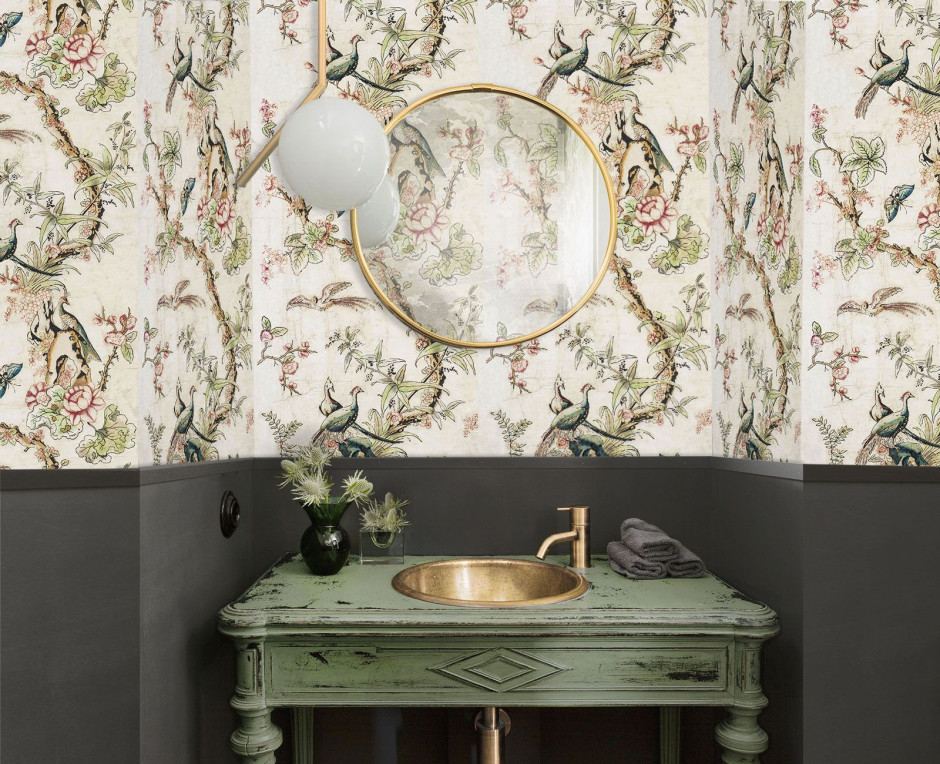No products
- LA PREMIUM finish ideal for walls, kitchen and bathroom
- L’EXTRA finish ideal for woodwork
You still have to place an order for additional boards
(boards are only sold by 3)
Wallpaper Birdhouse . 1775
Manufacturer Réveillon
115,00 €
Created around 1775, this original wallpaper is probably a creation of manufacturer Réveillon. It represents gnarled branches and many birds (pheasants, peacocks, birds with tuft ...) as well as peonies, flowering twigs, and butterflies. The outlines of this wallpaper were originally printed in one color using engraved woodblocks, on paper rolls bound together, and whose background was previously hand brushed. The colors were then applied with brush.
To give life and modernity to this very beautiful wallpaper from the end of the 18th century, our workshop carried out a long and careful digital restoration. Very few changes were made to the original pattern, and the irregularities of the paper were kept, which give it a charming, marbled effect.
Collection of Le Musée des Arts Décoratifs de Paris
Photographic credit: Les Arts Décoratifs/ Jean Tholance
MORE INFORMATION ABOUT LEAD TIMES, click here
Starting in 1753, Jean-Baptiste Réveillon imported flocked wallpapers from England. Then, during the Seven Years' War, because of the discontinuation of trade between France and England, he founded his first workshop in L’Aigle (Orne). In 1759, he set up his factory in Paris, rue du Faubourg Saint-Antoine, and successfully launched a complete range of wallpapers. In 1765, he bought a private mansion, La Folie Titon, surrounded by a park. He set up his factory there, on the ground floor, and kept the upper floors for his own accommodation.
In 1784, the factory obtained the title of “Manufacture Royale de papiers peints”, thus crowning 25 years of improvements and work. He provided significant assistance to the Montgolfier brothers for the construction of their first aerostats. But the days of April 1789 will soon mark the end of the factory (see "the Interesting facts"). As a result, in the midst of the French Revolution, Jean-Baptiste Réveillon emigrated into England, and in 1791, he rented out his factory to Jacquemart & Bénard, who would continue to produce wallpapers until 1840.
1775
La "Manufacture Royale Réveillon" was very famous in the 18th century. On April 28, 1789, it was the object of a popular revolt, heralding the storming of the Bastille, and more broadly the French Revolution.
At the origin of this revolt, Jean-Baptiste Réveillon made a proposal to the Government of Louis XVI, for abolishing the taxes levied on goods upon their they entering Paris, in order to stimulate consumption. This measure, allowing the prices of consumer goods to come down, also allowed employers to reduce the wages of their workers. It was therefore understood by the Parisian population as a proposal to lower wages. On April 28, 1789, it triggered a real revolt within the factory and ended in a bloodbath. The effigy of Jean-Baptiste Réveillon was then carried to Place de Grève and hanged.
This wallpaper was originally printed on laid paper, easily identifiable by its fine lines ("lays") visible by transparency. Used until the beginning of the 19th century, laid paper began to be replaced by vellum paper at the end of the 18th century in France. The vellum paper was plain, smooth and grain-free, reminiscent of the skin of stillborn calves (vellum). Invented in 1750 in England, it appeared in France in 1780. Two French printers, however, claimed its paternity: the Didot brothers and… Jean-Baptiste Réveillon! Keen on chemistry, he was behind the discovery of the new process for making vellum paper in 1782!
Our wallpapers are hung in 3 stages: the preparation of the wall, its pasting, and the hanging. The strips are hung edge to edge and from left to right in the order indicated on the assembly plan supplied with the rolls. To find out more, consult our Hanging instructions page.
Non-woven wallpaper 147g/ square meter
Matching edge to edge
Manufacturing time: 15 business days
Made in France
Standard size: 1 roll of 65 x 250/350 cm
Owing to the manufacturing process, there could be small variations in colors from one production batch to the next. If possible, avoid buying different parts of the same design several weeks apart.








